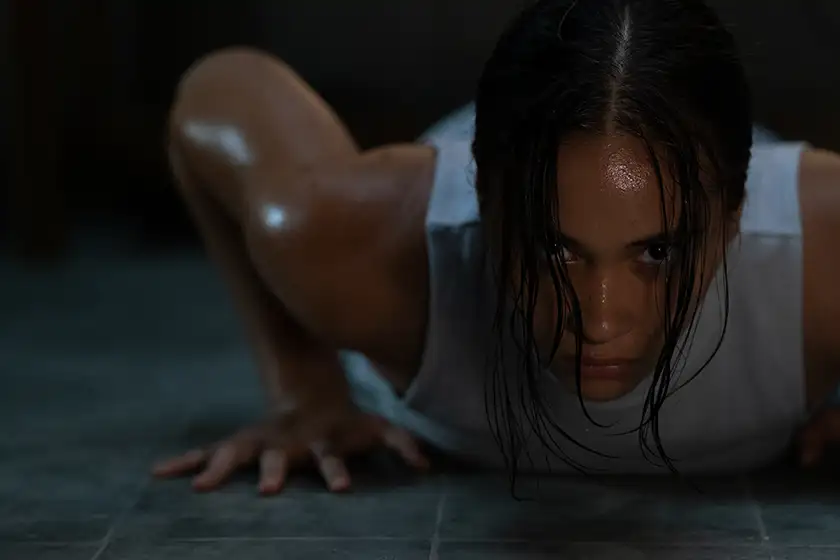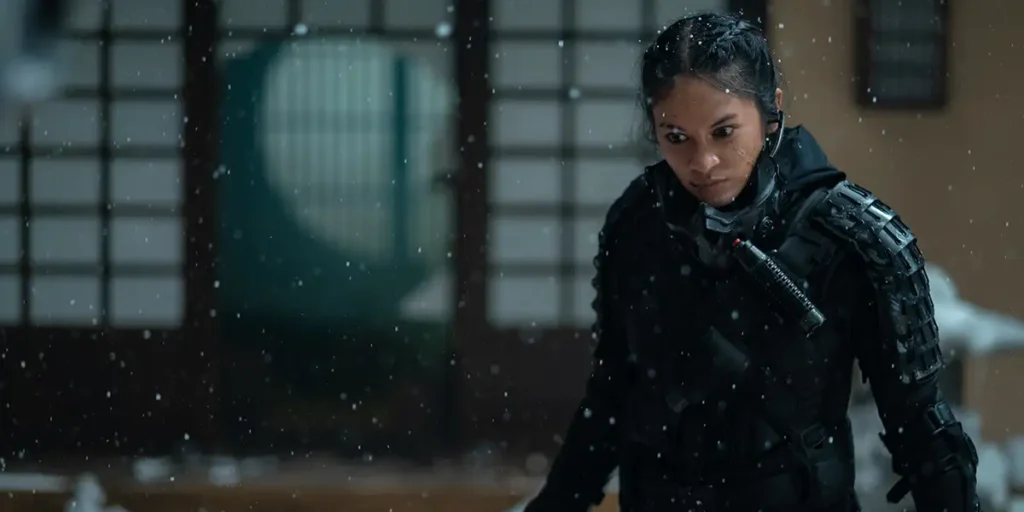Aurora Ribero magnifies the screen in Timo Tjahjanto’s The Shadow Strays, a 145-minute-long hyperviolent gorefest sure to satiate the sickos of the world.
Writer & Director: Timo Tjahjanto
Genre: Action, Crime, Thriller, Martial Arts
Run Time: 145′
World Premiere: TIFF
Streaming Release Date: October 17, 2024
Where to watch: Globally on Netflix
After seeing Timo Tjahjanto’s The Shadow Strays, I’m slightly baffled at some critics who qualified the film as “badass.” Sure, the action is hyperkinetic mayhem with plenty of satisfying, creative kills performed by its protagonist, 13 (Aurora Ribero). However, how its violence is visually treated and even choreographed seems so far away from the badass catharsis of filmmakers like Soi Cheang or the mind-blowing physical action-comedy of Yugo Sakamoto and Kensuke Sonomura.
Rather, the violence depicted in this 145-minute-long nonstop actioner is punishing. It begins right at the top of the movie, where 13 and Umbra (Hana Malasan) kill an entire Yakuza criminal line in the Japanese mountains. A head is immediately chopped off, and Tjahjanto lingers with the body before it falls off the ground. A hand is cut and used as a physical weapon, which then culminates in 13 using a body as a shield and gets violently shot before she grabs another body and stabs it to oblivion, as blood fills the lens. As cool as some may think it is, and it’s undoubtedly shot with tons of verve (one such image has an impressive backward tilt that reverses the image), there’s no world in which this kind of violence rewards, or even satisfies, our protagonist. It’s all punishment for her, whether literal or even figurative.
However, one must understand that this is a feature and not a bug. But it’s hard to qualify The Shadow Strays as “badass” when Tjahjanto posits 13 as a character born and raised out of violence (fragmented flashbacks give us clues about her past until it’s fully revealed near its conclusion). All she seemingly knows is killing, and she grows impatient when forced to lay low in Jakarta, take her prescribed pills, and await further instructions. During that time, she observes the death of Misrati (Jesyca Marlein), a sex worker whose unfortunate addiction to drugs led her straight to an overdose.
As a result, her son, Monji (Ali Fikry), is left alone to fend for himself. The two meet at a restaurant, and 13 grows a fond liking forto him. It’s the only moment in the entire film where we see glimmers of humanity inside an agent whose human qualities were erased from the moment she adopted the name “13.” The next day, and predictably so, Monji is kidnapped by club owner Haga (Agra Piliang). It doesn’t take long for 13 to figure out what’s going on, and she immediately plots to exact revenge on the people who want to hurt Monji, which include only Haga, alongside political figures Ariel (Andri Mashadi) and his father Soemitro (Arswendy Bening Swara).

The rest of the film is nonstop carnage, which is admittedly impressive to watch from a visual/aural perspective but is purposefully unenjoyable. I’d even say that if anyone tells you the film is “badass,” they’re likely a sicko who enjoys watching depraved, often perverse violence treated in the nastiest possible way. Each cut (of various body parts, and Tjahjanto has time to explore the whole body in 145 minutes, which he does) is not only explicitly violent but felt deep within our bones. Unlike many action movies that aestheticize violence and make it as pleasurable as possible for the viewer, Tjahjanto’s approach is often sickening, and he holds nothing back.
There isn’t a scene in which the viewer doesn’t feel as physically exhausted as our protagonist, who has to fight off a fresh horde of enemies every time she kills someone introduced as a primary antagonist and dies two scenes later in the most vicious way possible. This creates a new enemy who learns of a figure’s death and, in turn, goes after 13. Rinse and repeat until its thrilling conclusion, which finally gives purpose to 13’s quest for redemption, freed from the shackles of violence (though it seems far more complex than this, as its end credits scene teases another carnage-heavy sequel).
While many will describe the punishing physical toll of violence on 13, what’s most interesting is how Tjahjanto operates on an entirely psychologically active level through endless amounts of blood released from all body parts and conduits humans might have never thought existed until this film. 13 knows full well that, if she doesn’t change course, this sustained level of extreme violence will bring her to the ultimate punishment far sooner than later, especially when it is revealed that her own team is going after her for having broken her instructions and meddling in affairs she had no business even lightly poking in.
But there’s something in Monji’s innocent, almost pure nature that she slowly connects with. For the first time since joining the shadowy organization she’s a part of, there’s a longing hope for a better life, and saving Monji may hold the key to leading her to it. But, of course, since this film is all about punishment, things never go the way 13 envisions, leading to some of the cruelest character decisions of Tjahjanto’s genre filmmaking career. Some people might have thought the director crossed a line. And perhaps if such a moment were exploitatively captured (such as in Venkat Prabhu’s The Greatest of All Time), I would’ve agreed.
But Tjahjanto is so empathetic and protective of his protagonist that we ultimately care about her plight of breaking away from punishment and attaining a rewarding, fulfilling life, even if the path to freedom is, so far, sending her further into the depths of hell. Representing this emotional journey can prove complex, but Ribero is in complete control here, magnifying the camera and conveying pain in subtly devastating ways. It doesn’t take long for us to sympathize with her. She’s not an irredeemable killing machine (as some protagonists in action films do tend to be), but someone who sadly does not know any better than the life she unfortunately did not choose.
Tjahjanto constantly lingers on her face, whether through extreme close-ups in action sequences or a constantly evolving language that represents her pain and anguish when the situation goes in an even worse direction than it initially did. It compels us to watch the movie until the very end, even if its concluding section stretches the runtime to nearly interminable heights. At some point, the violence, while always furiously shot, choreographed, and edited in a way that reinvents the genre not as an anchor of emotion but as constant, bludgeoning pain, becomes less impactful and frequently mind-numbing.
Perhaps that was the point, but I appreciated how Tjahjanto draws an unsubtle commentary on punishment through violence rather than the senseless finale that only seems to revel in gratuitous action. However, this is a minimal issue of a movie that, whether for better or worse, kicks incredible amounts of adrenaline into our system. Is it “badass”? I’d beg to differ, especially in how unpleasantly treated its violence is. But it’s undoubtedly one of the best and most thrilling action movies of the year, with choreography vastly distinct from some of the most compelling genre works in the independent sphere released in 2024.
That said, if one makes a triple feature with Yugo Sakamoto’s Baby Assassins: Nice Days, Soi Cheang’s Twilight of the Warriors: Walled In, and Timo Tjahjanto’s The Shadow Strays (in that specific order), their brain may melt permanently. Whether that’s good or not is up to you to decide, and discover on your own.
The Shadow Strays is now available to watch on Netflix.

